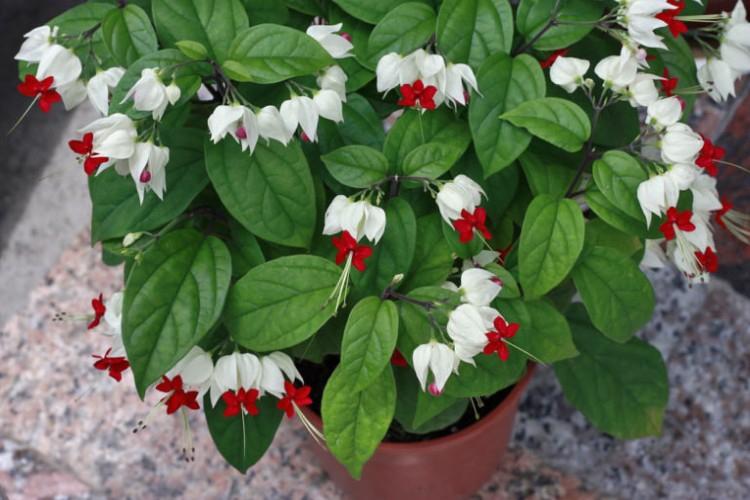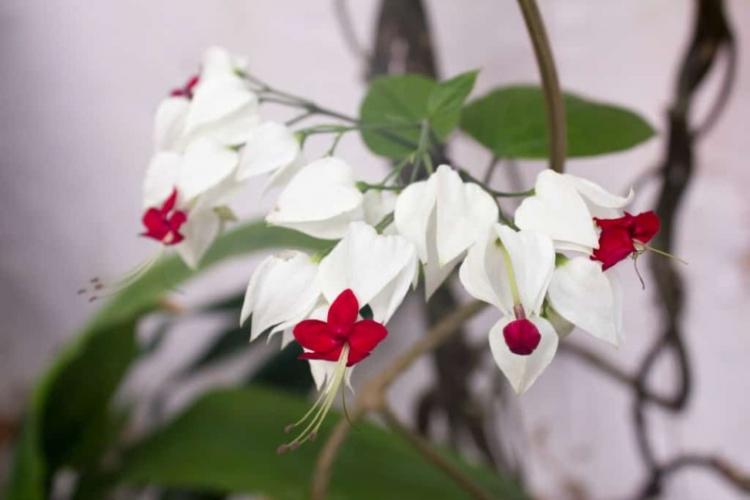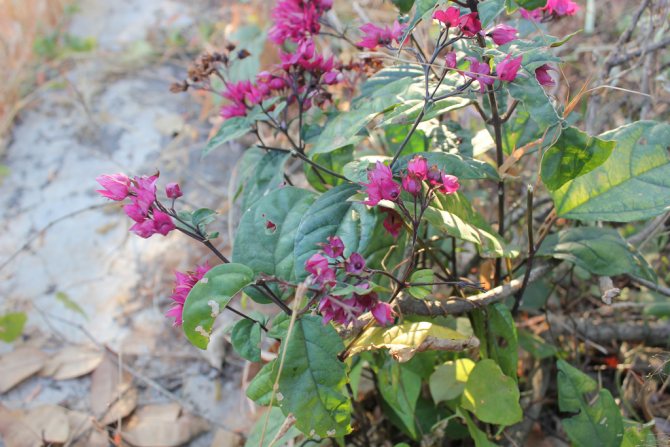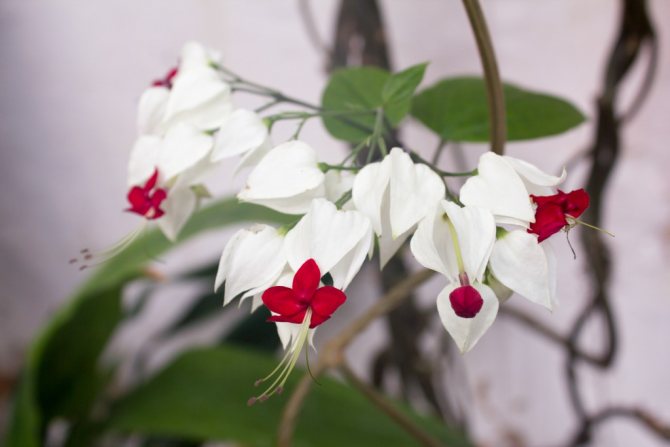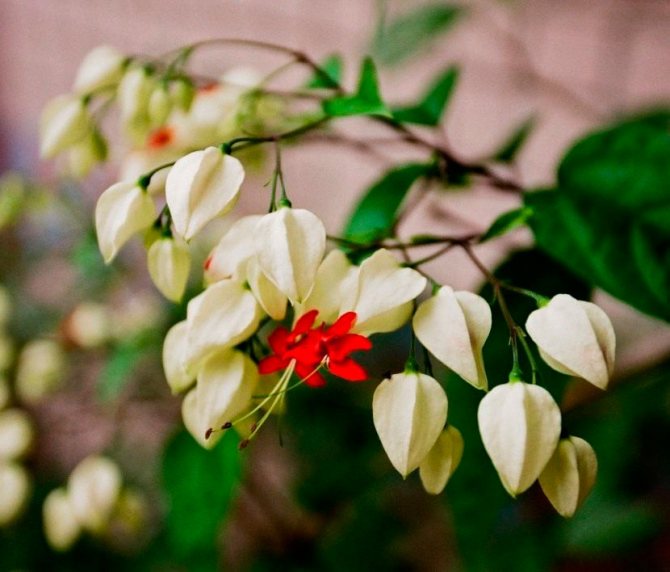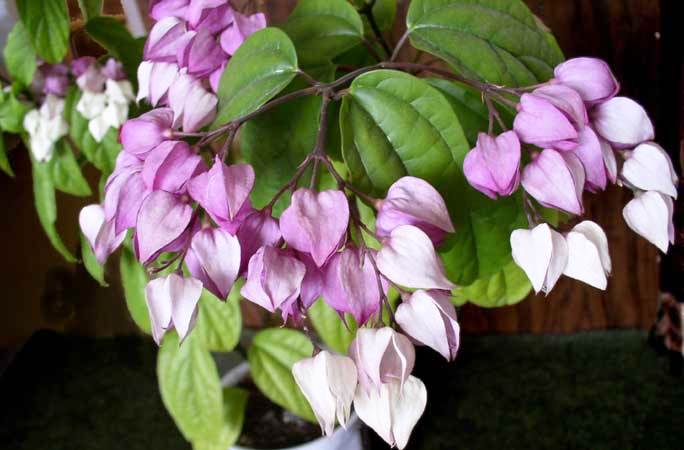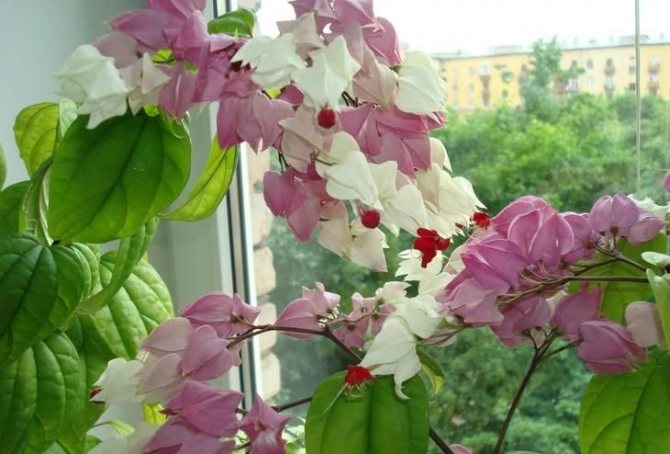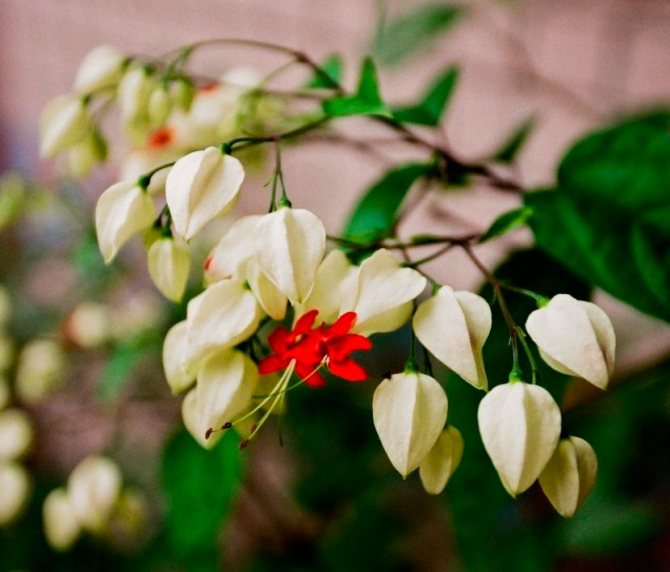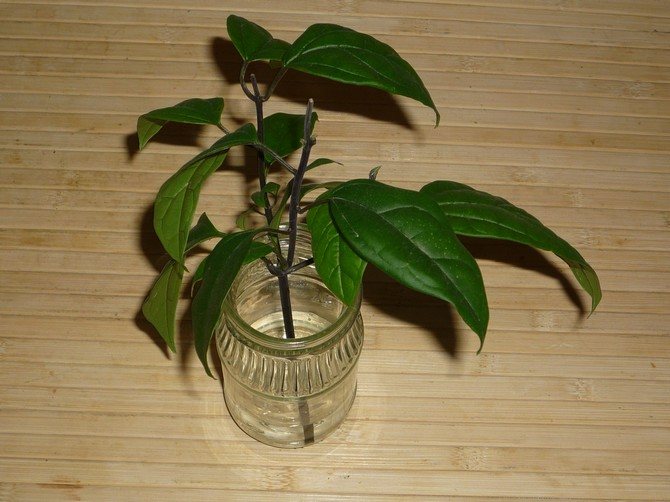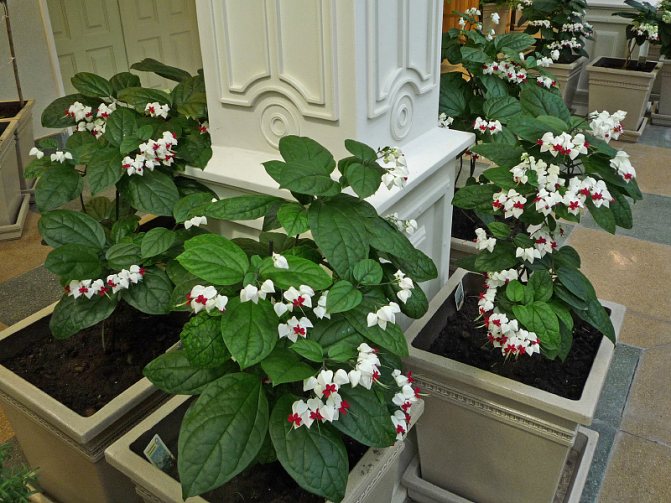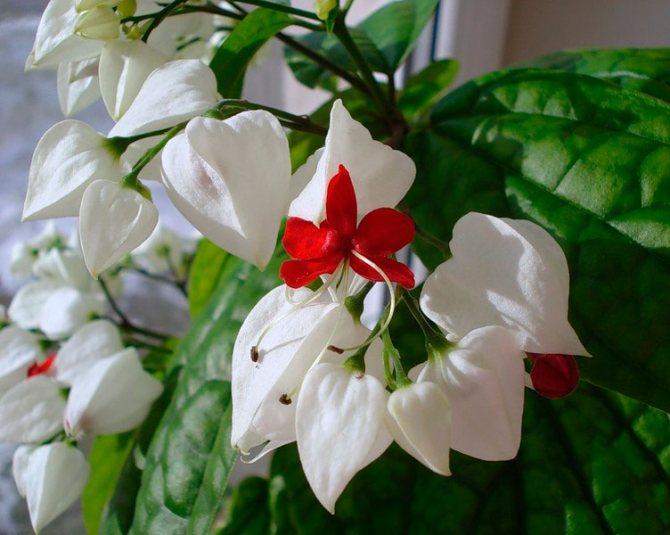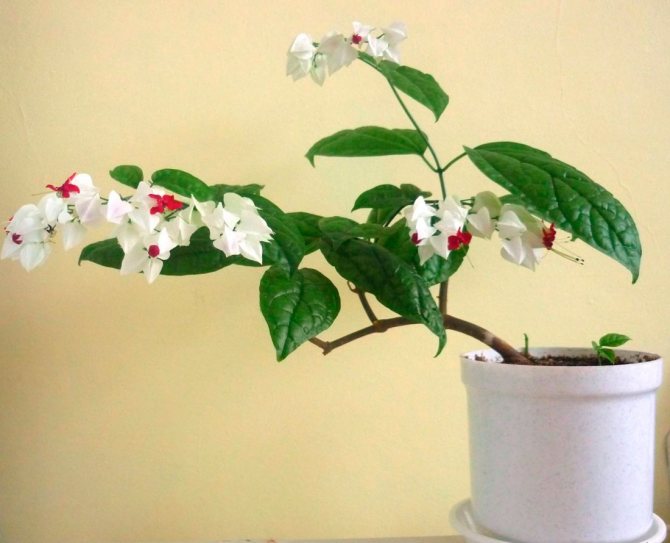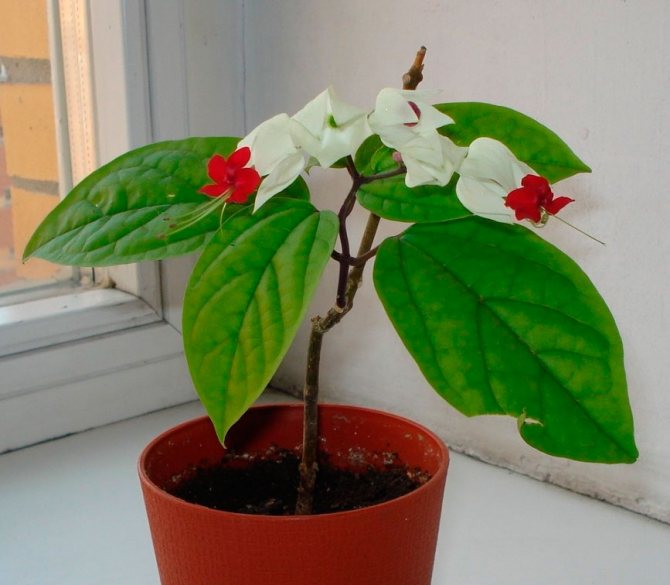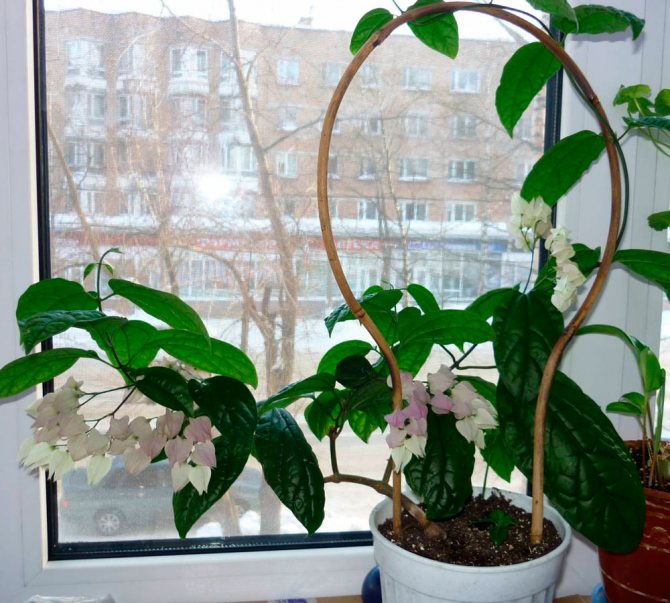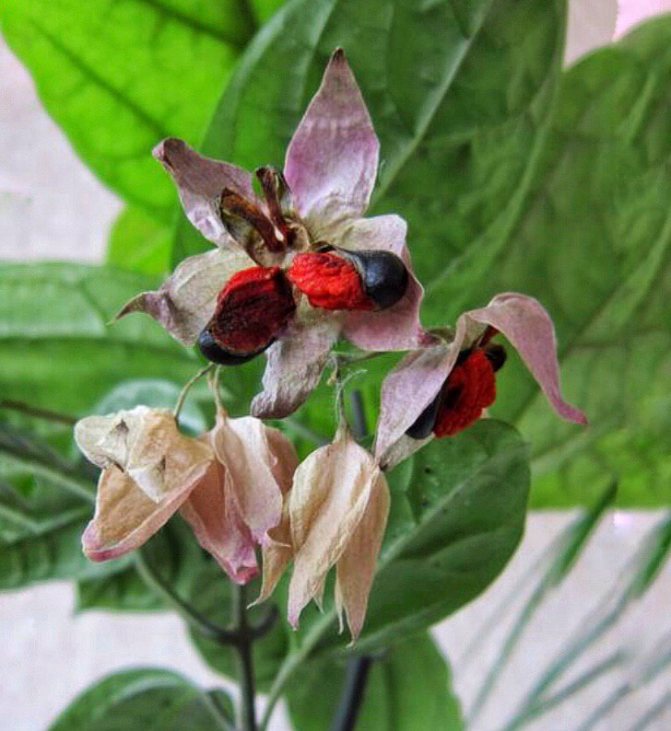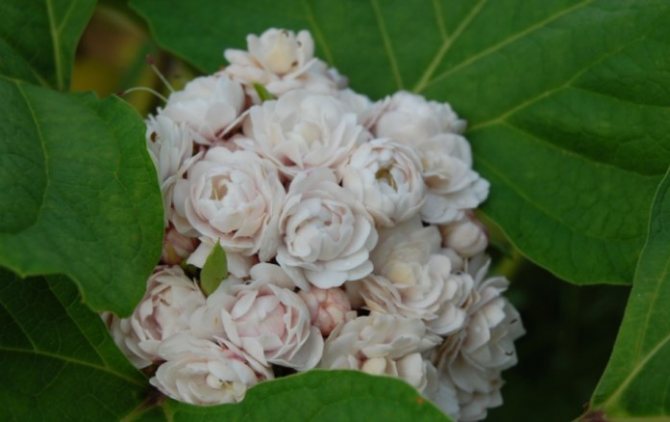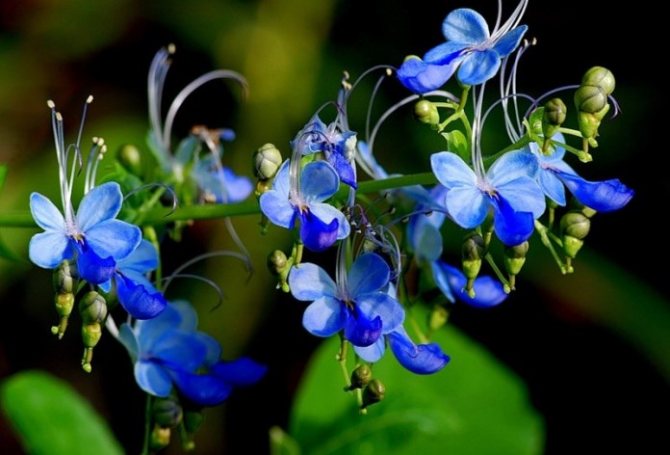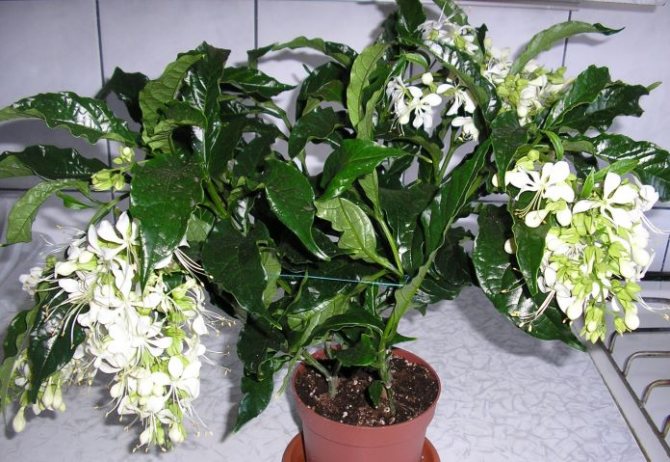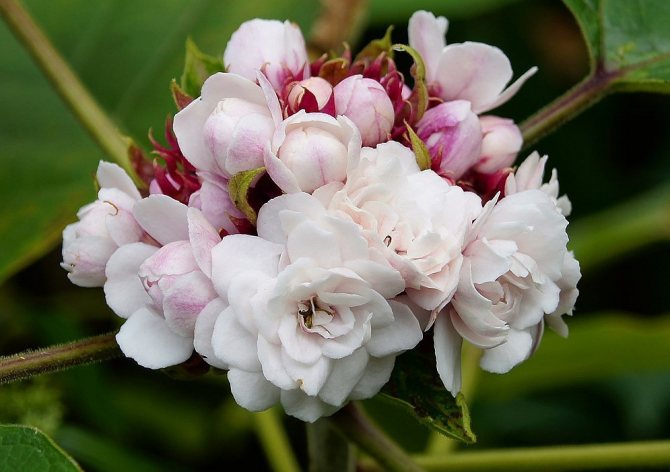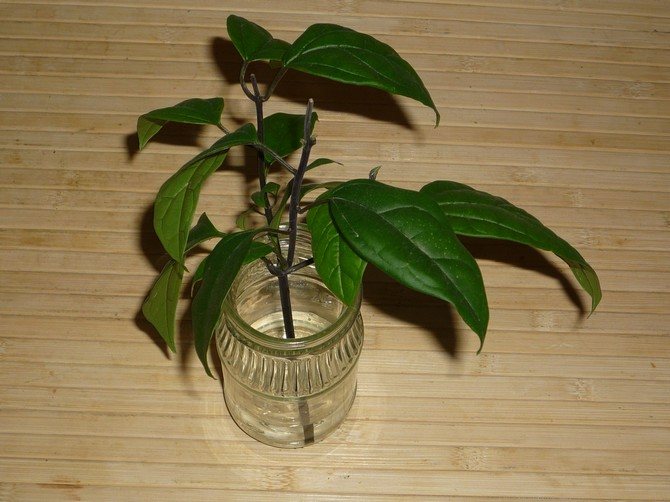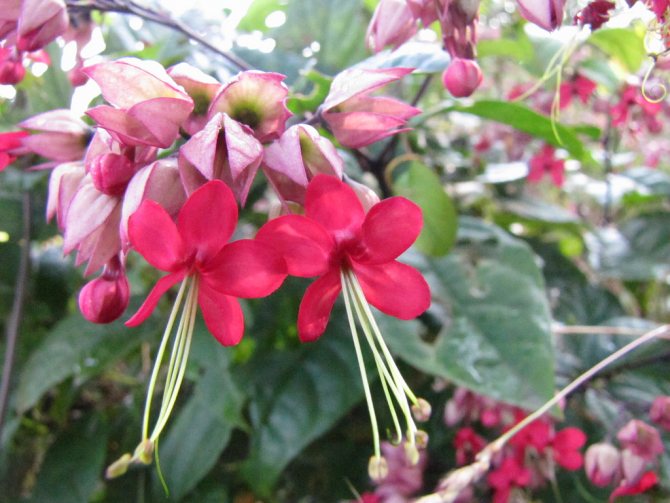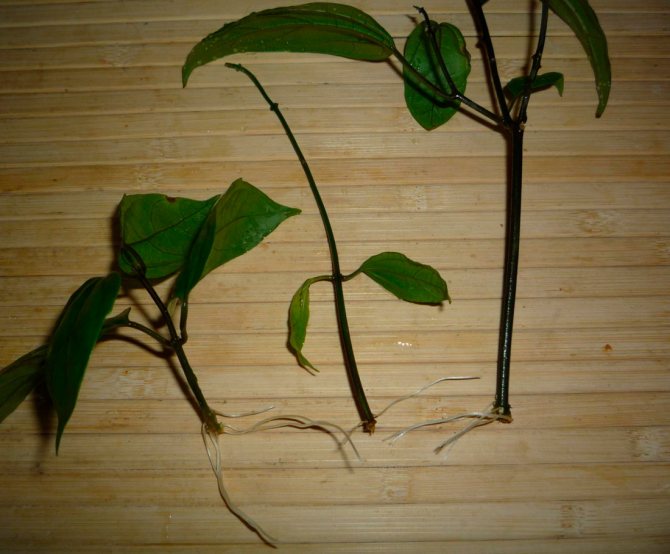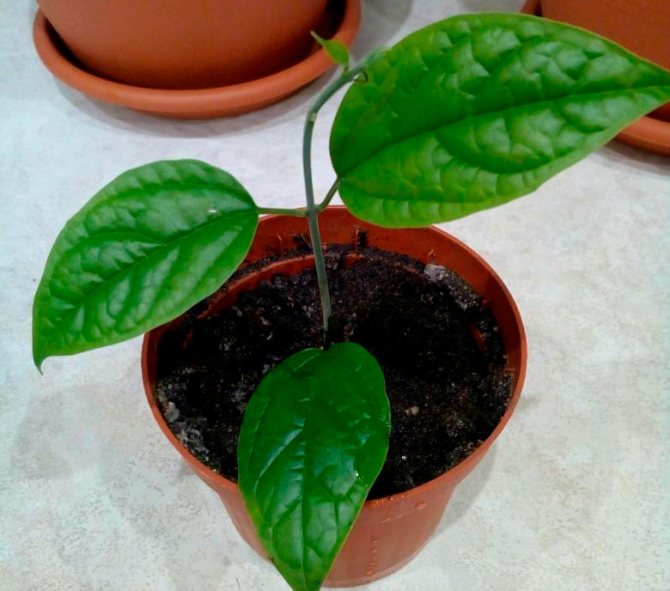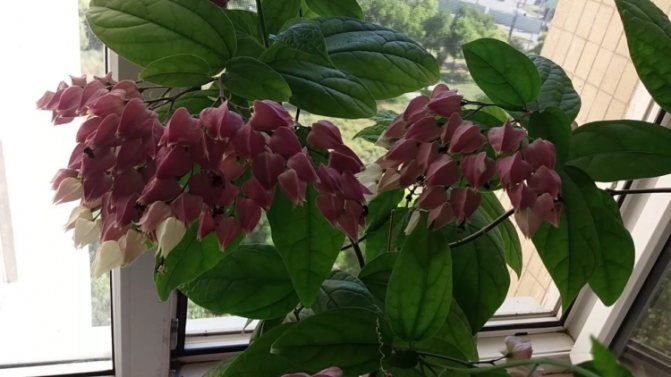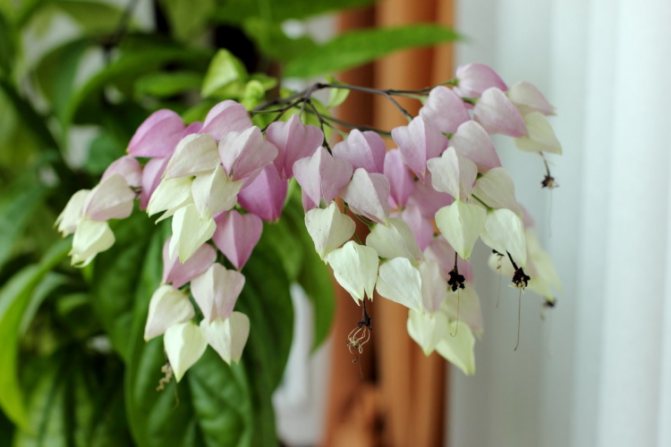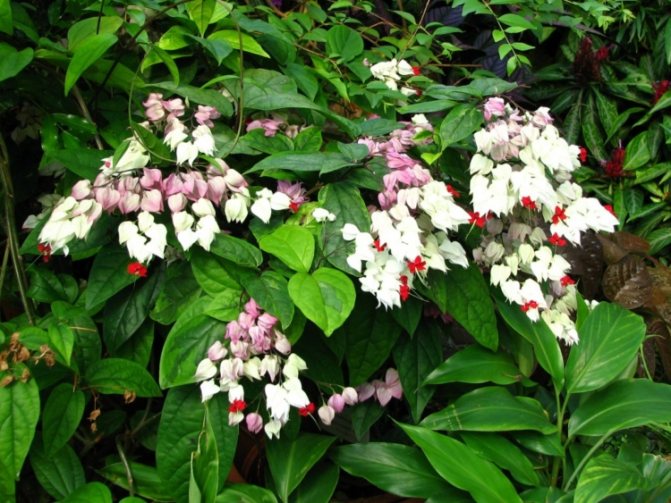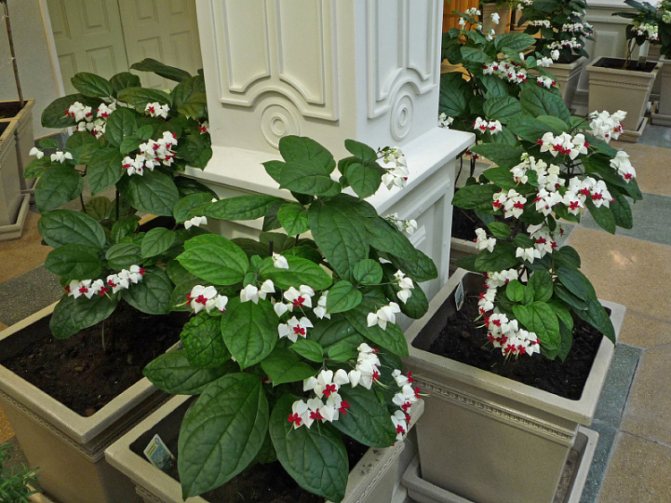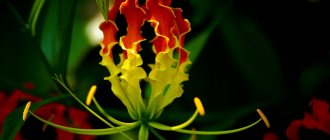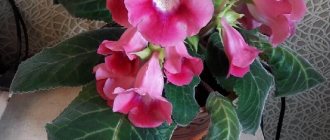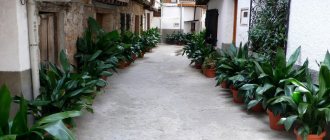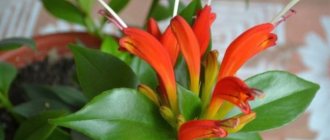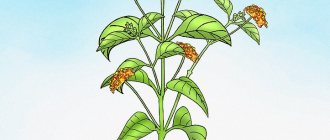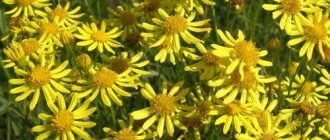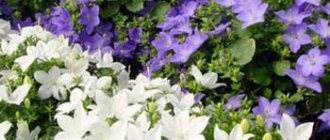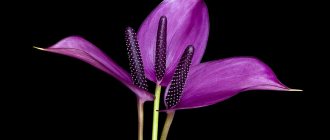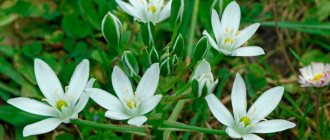Clerodendrum thomsoniae in England has long been referred to as "the vine of the bleeding heart." This deciduous plant is an ornamental vine and belongs to the Verbenov family.
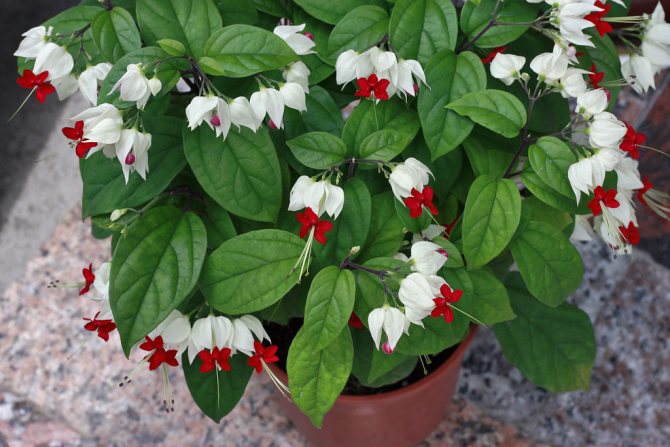
Clerodendrum originates from the African tropics; they began to grow it at home a couple of centuries ago, today there are more than four hundred species of this plant. Florists and landscape designers actively use this beautiful vine to decorate the exposition; amateur florists grow a flower at home. This flower was named in honor of the discoverer from Scotland, George Thompson, who brought Clerodendrum to Europe from African countries. Some also call this plant Mrs. Thompson's clerodendrum, after the wife of the Scottish scientist.
Botanical description
In the natural environment, the liana grows up to 4 meters in length, in the home - up to two. Long flowering is inherent in the plant, up to 6 months, starting from March - April and ending in September - October.
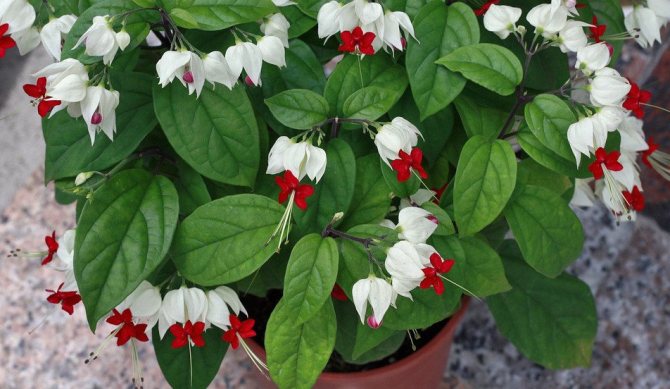

Characteristics of Thompson's Clerodendrum:
| Stem | Curly, woody liana |
| Leaf shape | Oval, grooved along the veins, up to 12 cm in length |
| Leaf color | Green |
| Flower shape | Bracts - in the form of inverted cups or bells up to 3 cm in diameter.Flowers - in the form of a five-lobed corolla with stamens |
| Flower color | Bracts - white, turn pink over time, turn lilac; flowers - bright red, eventually become dark cherry |
| Fruit shape | Oval, length about 1 cm |
| Fruit color | Orange |
Biological characteristics
Clerodendrum Thomsoniae is a type of flowering vine from the genus Clerodendrum, Verbenaceae family. It is an evergreen plant that can grow up to 4 m in height. Its leaves are bright green, oblong, up to 17 cm long, on average 13-14 cm with pronounced veins. Five-petalled flowers up to 2.5 cm in diameter are formed in clusters from 8 to 20 pcs. on one in sympodial inflorescences. The color ranges from pure white to lilac and crimson hues. Corolla is red with 5 petals and 2 cm long.
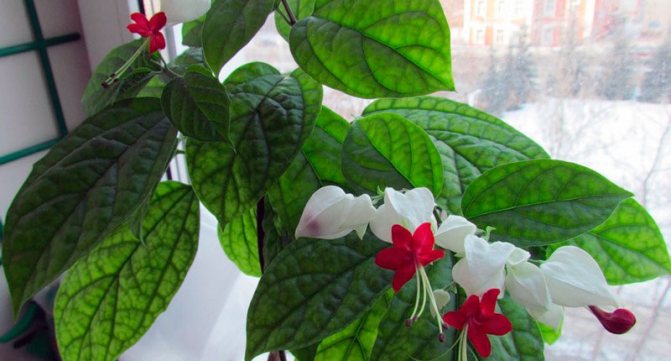

Clerodendrum Thompson
Plant name
Translated from the Greek “Kleros” means “fate, lot, luck”, and “Dendron” means “tree”. The name of the flower can be different: bleeding glory, grapes with a bleeding heart, begflower, but these names can also be applied to the other 400 species of the genus Clerodendrum.
Where the name comes from is unknown to the end. There are several versions:
- In the nineteenth century. lived Scottish missionary D. Thompson, who came to Cameroon to collect flowers for the Royal Botanic Gardens in Kew and the British Museum.
- George had a nephew W. Cooper Thompson, who was also a missionary, but already in Nigeria, and it was in his honor that the plant was named (originally a bleeding heart, after it was renamed to Clerodendrum Thompson).
- William was married, and after his wife died, he asked to name a flower after her. Therefore, sometimes you can hear the name Clerodendrum of Mrs. Thompson.
In general, there is no exact version, but it is clear that the name revolves around one family of missionaries.
Note! The genus of plants is very rich, but mainly Mehonsol, Thompson, Wallich's Clerodendrum, Ugandan, Filipino, Spezum, Tripartite and Bunge are grown.
Natural habitat
The plant was brought from western Africa, or rather from Cameroon westward to Senegal. In some regions, it was never possible to cultivate it, so it has been naturalized.
Conditions for growing at home
Growing at home involves observing temperature and humidity conditions, as well as the correct location.
Location
In its natural habitat, Thompson's clerodendrum grows under tree crowns, so it needs the right balance of light and shade. The most suitable location is on the windowsills of the east and west windows. If the windows are on the south side, then a pot with a vine is placed deep into the room to organize a shade that will help avoid direct sunlight. In the case when the windows are on the north side, it is recommended to use additional lighting during the growing season and flowering (from mid-spring to mid-autumn).
Did you know? This type of clerodendrum was named after the Scottish missionary George Thompson. Thanks to him, the flower got to the countries of Europe.
Temperature
In a warm period, the optimum temperature for the clerodendrum is + 19 ... + 25 ° C, if the specified range is exceeded, it is recommended to correct it with an air conditioner.
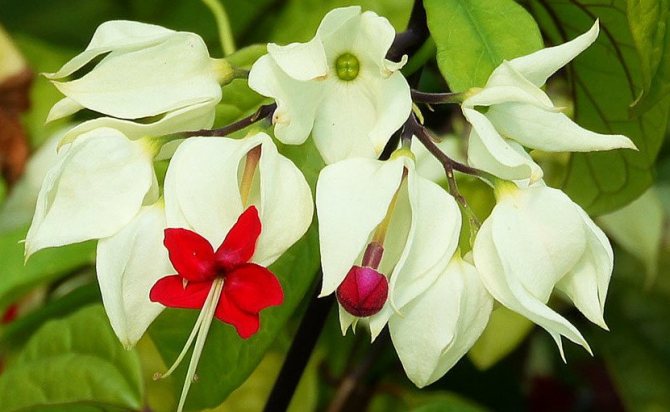

After flowering, there is a dormant period (late autumn - late winter), in which it sheds its leaves. A plant without leaves must be kept in a room with a temperature of + 12 ... + 15 ° C, otherwise next year it may give very poor flowering or not bloom at all.
Air humidity
Thompson's Clerodendrum needs high humidity. To maintain moisture, the vine is often sprayed with a spray bottle. It is especially important to carry out this procedure on hot summer days and when heating devices are in operation, as they dry the air. After clerodendrum has dropped the leaves, spraying must be stopped.
Important! During the heating period, it is forbidden to place the clerodendrum near a radiator or other heating devices in order to avoid dry air, which can lead to illness.
Bush formation
Gloriosa flower: home care and planting examples
Forming a bush is a very interesting procedure, and Thompson's clerodendrum works well for this. It can be grown as an ampelous flower, or, for example, you can let it go along the perimeter that the owner of the plant wants. That is, you can make some kind of frame and grow along it, either around the room, or in any other shape.
Note! It is also possible to give it a racemose or a standard tree using formative pruning.
Home care
Thompson's Clerodendrum is quite demanding in its care, so it is important to know exactly how to care for it.
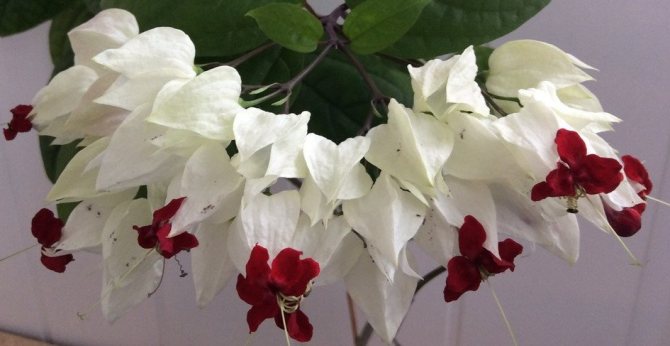

Watering
The plant needs regular moisture. Watering is increased during the period of growth and flowering. It is important to maintain a stable level of soil moisture without overdrying or flooding it. Complete drying of the soil entails wilting and falling of leaves, and dampness - rotting of the root system. It is possible to understand that it is time to water the plant if the top layer of the soil (about 2–3 cm) has dried out a little. In summer, watering is usually carried out 1-2 times a week, by autumn the amount is gradually reduced. In the cold period, the liana absorbs water worse, so it needs to be watered less abundantly.
Important! It is necessary that the water for irrigation is settled for at least 3 days.
For irrigation, it is recommended to use settled water heated to room temperature.
Top dressing
Clerodendrum is fed from early March to late November, until the dormant period begins. You can feed with fertilizer for flowering indoor plants in liquid form. To improve flowering, you can use fertilizers that contain potassium and phosphorus. Preparations that contain nitrogen, it is advisable to use only at the beginning of the growing season. In the spring and summer, the plant is fertilized once a week, in the fall - once a month, in the winter, feeding is completely stopped.
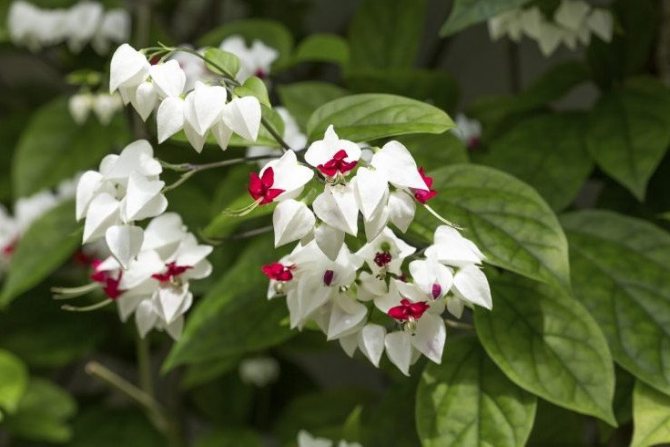

Pruning
Pruning Thompson's clerodendrum is necessary in early spring (when foliage appears, before active growth begins). This should be done annually. Pruning not only improves the appearance of the vine, but also helps shape its crown. Thanks to this, Thompson's clerodendrum can be arranged as a shrub, standard tree, etc. When pruning shoots, approximately one third of the length is cut, thereby stimulating the growth of lateral branches.
Transfer
One of the important aspects of care is the transplant. Young plants are transplanted every year, older plants - every 2-3 years. The transplant is carried out in the spring, before the start of active growth, but after pruning.
We advise you to read about home care for Filipino Clerodendrum.
You can take the soil for transplanting purchased, but be sure to add peat, sand, humus and coniferous soil (in equal parts) to it. You can also take rose primer and azalea primer and mix them in a 4: 1 ratio. Before planting, the soil must be disinfected.
The pot should be taken with a diameter of about 2 cm larger than the previous one.
To carry out a transplant, you must:
- Place expanded clay drainage in a pot with a layer of 2 to 4 cm in height.
- Gently transfer the clerodendrum from one pot to another.
- Cover empty places with new substrate.
- Water the sprouts.
- Carefully observe the vine for 5 days in order to understand whether it has managed to adapt to the new conditions.
Video: transplanting and pruning Clerodendrum Thompson
Types of clerodendrum with photos and names
Clerodendrum thomsoniae


This type is most popular among florists. It is represented by a deciduous ligneous vine, which has thin, smooth stems. Large dense leaf plates of dark green color are whole-edged; veins are clearly visible on their surface. The length of the leaves is about 12 centimeters, and their shape is oblong-ovate, pointed. On the front surface of the foliage, specks of irregular shape are located, which can be painted in darker and lighter shades. Swollen white flowers have a red corolla; they are part of the axillary loose brushes. In indoor conditions, this species is distinguished by its rapid growth, it is propagated exclusively by cuttings, and flowering lasts from March to June.
Clerodendrum splendens
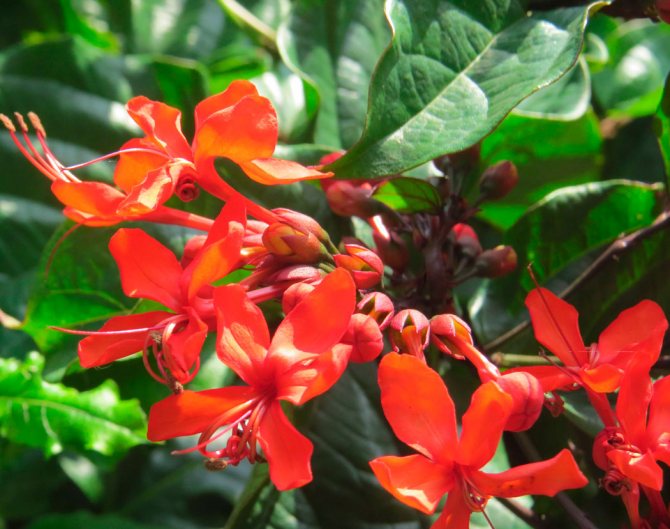

This evergreen shrub has curly stems that adorn the leaf plates of an almost round shape with a heart-shaped base, they have a wavy edge and an oblong pointed tip. The plates are 8 centimeters long and 6 centimeters wide. Short axillary inflorescences of corymbose or racemose form consist of scarlet-red flowers. Flowering lasts almost throughout the year.
Clerodendrum philippinum
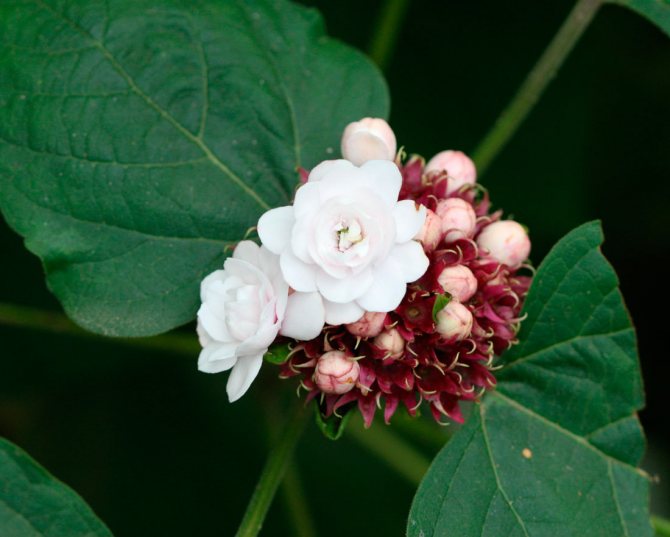

This species differs from the others in that it has a pungent, but pleasant vanilla-jasmine scent, in the evening it becomes even stronger. This species is grown by flower growers relatively rarely, although it is quite easy to care for it, since it is undemanding to care for. Already in the second year of life, spectacular whitish-pink inflorescences appear on the bush, having a diameter of about 20 centimeters, they include pink-shaped flowers, reaching from 20 to 30 mm in diameter. They look very impressive against the background of dark green wide leaf plates.
Clerodendrum ugandense
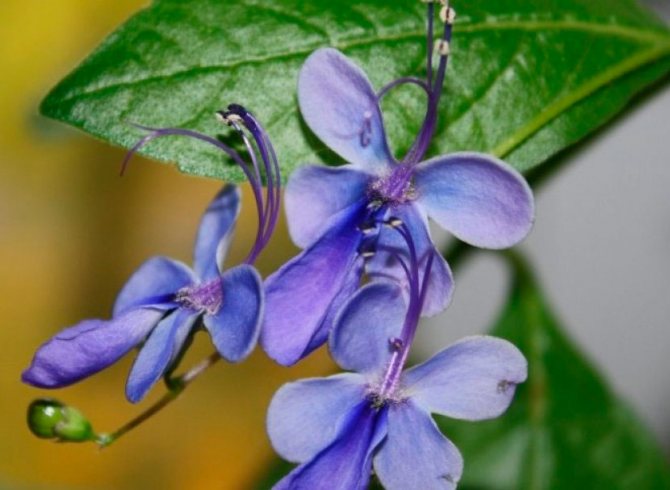

This evergreen liana is characterized by rapid growth, its length can reach 200 cm. The shape of the dark green leaf plates is broad-lanceolate. The terminal few-flowered loose inflorescences consist of flowers that are very similar to butterflies, thanks to the blue filamentous stamens, resembling antennae.The lateral as well as the upper petals are blue in color, while the barely distinguishable lower petal is colored purple or bluish-lilac. With the help of pruning, this type can be given the shape of a tree or a bush.
Fragrant Clerodendrum (Clerodendrum fragrans)


This shrub is evergreen and reaches a height of about 200 cm. There is pubescence on the surface of the stems. Broadly ovate leaf plates are also pubescent, they reach up to 20 centimeters in length and have deep denticles along the edge. Lush corymbose apical inflorescences, reaching about 80 mm in diameter, consist of double or simple white flowers with a pinkish tinge on the outside, their smell is similar to citrus and violet. Flowering lasts almost all year round.
Wallich's Clerodendrum, or Prospero's Clerodendrum


This type is also called the bride's veil, or Cleopatra's tears, or the bride's veil. It blooms very luxuriantly with snow-white inflorescences, which consist of flowers of an unusual very refined shape. The bush is compact and very graceful, its stems are tetrahedral, and they are decorated with lanceolate leaf plates of a dark green color, which reach 50–80 mm in length, with a wavy edge. This species differs from the others in its high demands on growing conditions. For normal growth and development, he needs high humidity and a special daylight hours.
Reproduction
There are two ways to propagate a plant - growing from seeds and by cuttings.
Cuttings
You can get cuttings for planting by pruning the plant. Choose those that have from 4 leaves and at least 9 cm in height.
Reproduction by cuttings is carried out as follows:
- The cuttings are placed in a container with boiled water so that they take root.
- After the roots appear, they are planted in a loose substrate.
- After disembarkation, cover with plastic wrap and place in a bright place with a temperature of +21 ° C.
- When rooting occurs (from 4 to 6 weeks), transplanted in containers with compost soil.
- About a year after rooting, the clerodendrum is planted in the soil for an adult plant.
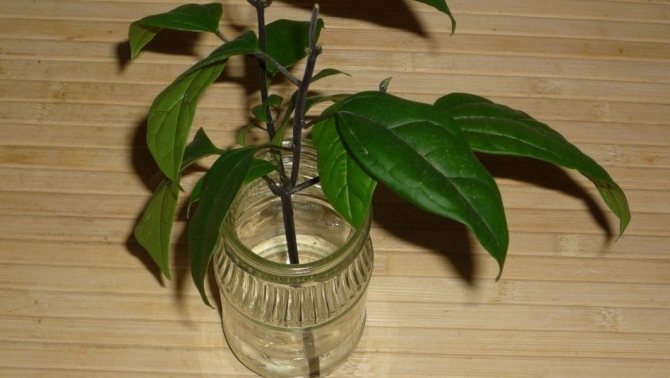

Growing from seeds
Sowing seeds for propagation begins in late February - early March.
The cultivation takes place as follows:
- The seeds are sown in the substrate. The substrate should consist of sand, turf and peat.
- The sown seeds are placed in greenhouse conditions, keeping the room well lit.
- Sunrises should appear in 6-8 weeks on average. When the sunrise has at least 4 leaves, it is transplanted into separate containers.
- After rooting and growth, the sprouts are accustomed to the conditions of caring for adult clerodendrum.
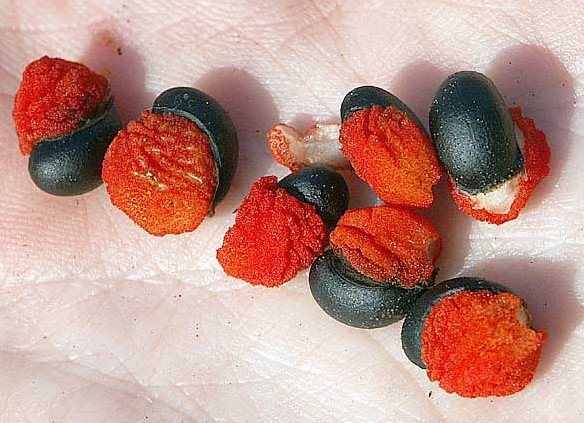

Why Thompson's Clerodendrum does not bloom
Clerodendrum may not bloom because it lacks light, nutrients, and water. In general, artificial conditions are not so close to natural ones. Therefore, you need to monitor the characteristics vital for the clerodendrum. You can also carry out the following operation: after the formation of the crown (somewhere in February), you need to leave the shoots (about 60 cm in length), and the leaves, in turn, should be cut off. In late March - early April, there will already be the first flowers. But for this procedure, the plant must be an adult.
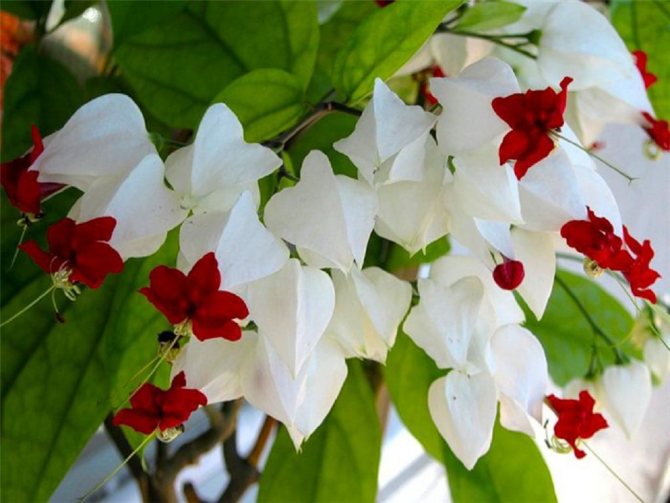

Lush green flower
Clerodendrum Thompson needs to arrange conditions that are as close to natural as possible in order to get flowering and proper flower development. However, this will not require a lot of time and effort. Clerodendrum Thomsoniae is an interesting, not very whimsical plant, which is easy to care for and which will delight the residents of the house with its appearance.
Difficulties of growing
Most of the difficulties in growing arise if you do not adhere to the rules of plant care. In addition, there are diseases and pests that can harm the clerodendrum.
Why does not it bloom
One of the most common difficulties in growing Thompson's maple that novice growers face is the lack of flowering. The reason for this phenomenon is non-compliance with the basic rules of care.
Let's consider some violations and ways to fix them:
- Improper care during the rest period... To make your clerodendrum bloom in the spring, you need to help it rest and strengthen in winter. To do this, when the flowering ends and the leaves begin to fall off, the amount of watering is reduced and the plant is transferred to a cool room with a temperature of no more than + 15 ° C for 6–8 weeks. As soon as the flower begins to sprout new shoots, it is necessary to increase the number of watering, cut it, transplant it and transfer it to a warm room.
Did you know? In some European countries, Thompson's clerodendrum is called the vine of the bleeding heart, this is due to the fact that the white bracts are shaped like a heart, and the red flowers are drops of blood. - Lack of lighting... If there is not enough natural light, for example, when the windows of the room in which the clerodendrum is located face north, then additional lighting must be used.
Diseases
Clerodendrum can hurt due to violations of the rules of care: insufficient or excessive amount of moisture, lighting, incorrect room temperature.
The reason for yellowed leaves may be a lack of moisture or watering with hard (not settled) water. In cases where the leaves begin to become covered with dark spots, it is possible that direct sunlight falls on them, and it is necessary to change the location of the vine.
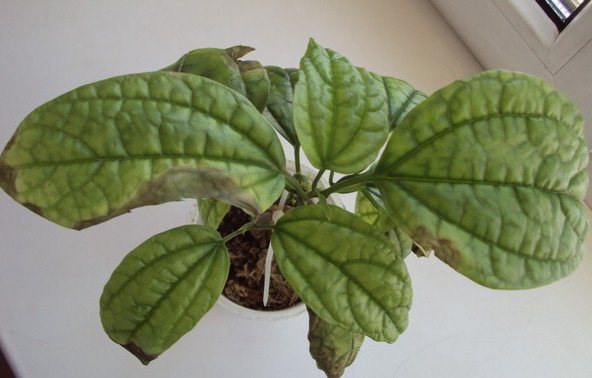

Pests
Consider the pests that can attack the plant, and ways to combat them:
- whitefly butterfly... This insect places its larvae on the leaves, which causes the leaves to change shape and fall off. In order to get rid of this pest, the leaves are treated with an insecticide every 3 days for 2 weeks. Leaves containing whitefly larvae must be destroyed;
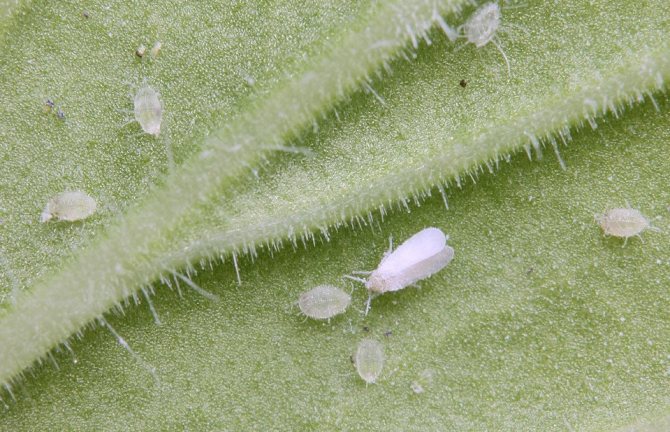

- aphid... Symptoms of the attack of this pest are poor growth, deformation, wilting of the plant. Control methods are similar to whitefly control methods. Also, you can treat the leaves of a flower not with an insecticide, but with a soapy solution;
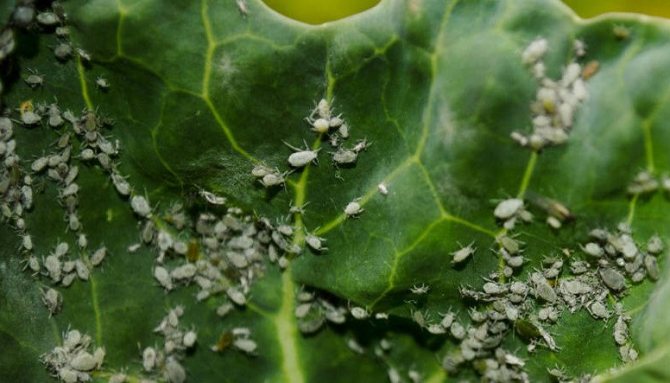

- scabbard... The attack of this pest is evidenced by yellow spots on the leaves, their fall. To destroy the scabbard, the leaves are treated with soapy water every 3 days.
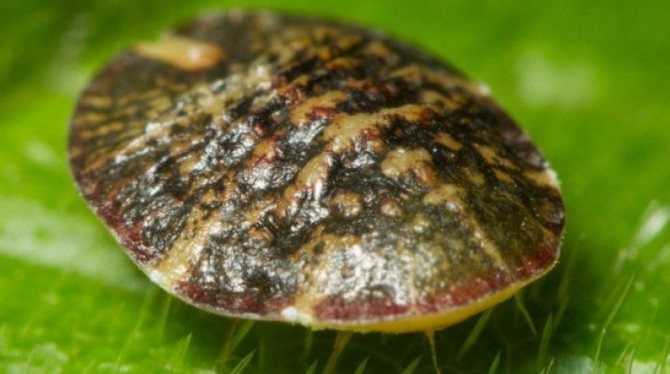

Pests and diseases of clerodendrum
Pests
Insects such as whiteflies and spider mites are most commonly harmed by the clerodendrum. As a rule, whitefly can be found on the lower surface of the leaf plates, and on the front side of the leaf, due to the presence of pest feces, a shiny bloom appears, which is called honeydew or honeydew. If a spider mite settles on a flower, then you will not be able to see it with the naked eye. White dots that appear on the seamy surface of the foliage will tell you about its presence on the plant, and you can also find a very thin web on the bush. To get rid of both the tick and the whitefly, clerodendrum can be treated with an insecticidal preparation. For example, take 1 liter of water and combine it with one ampoule of Actellik, treat the plant with the resulting solution. If necessary, you can carry out four sprays with a break of three days.
Clerodendrum does not bloom


Often, beginners when growing clerodendrum are faced with such a problem as the lack of flowering. Moreover, the cause of this problem is often very simple and at the same time unexpected. If you understand that clerodendrum refuses to bloom due to improper care, and try to fix everything, then soon all problems will be resolved by themselves. Most often, Clerodendrum does not bloom if it was in unsuitable conditions during the winter.
Can clerodendrum be made to bloom? In order to see the beautiful flowering of such a plant in spring, you need to keep it cool in winter. Immediately after the bush has faded, watering is gradually reduced, and it is also removed to a rather cold place (the air temperature is not higher than 15 degrees). Best of all, the culture hibernates at a temperature of about 12 degrees, while watering should be rare and scarce, but the earthen coma should not be allowed to completely dry out.
The dormant period lasts about 6-8 weeks, during this time the plant has time to rest well and stock up on strength for a new growing season and flowering. After the young shoots appear at the bush, gradually resume normal watering, cut it off and, if necessary, transplant it. Put the clerodendrum in its permanent place and start feeding it regularly again.
Remember to keep your potting soil fertile at all times. Often the bush refuses to bloom even if it has not been transplanted for a very long time. And the plant may not bloom due to poor lighting, in this case, already formed buds sometimes crumble.
Clerodendrum turns yellow


In the event that yellowing of the foliage is observed in the spring-summer period, then this may be due to rather rare and scarce watering. To fix this, water more often or pour more water into the pot and remember that there must be some liquid in the pan at all times.
The appearance of yellow spots on foliage may be associated with the development of chlorosis. In this case, an iron-containing agent can help clerodendrum.
Flying around foliage
In the event that the leaves fall during the cold season, then this can be a completely natural process. This can be observed in all deciduous plants. As a rule, foliage gradually turns yellow and flies around during the autumn-winter period. But if the foliage is flying around in the warm season, then most likely the flower is not properly looked after or it needs to be moved to another place.
Folk omens and superstitions
Clerodendrum is called the tree of fate, its history is shrouded in omens and superstitions. Some of them say that the plant brings good luck, happiness and wealth to its owner, some, on the contrary, promise grief and illness from the flower.
There is a popular belief that a woman who grows Thompson's clerodendrum at home is doomed to loneliness and will never marry. How true this is, how much not - it's up to you.
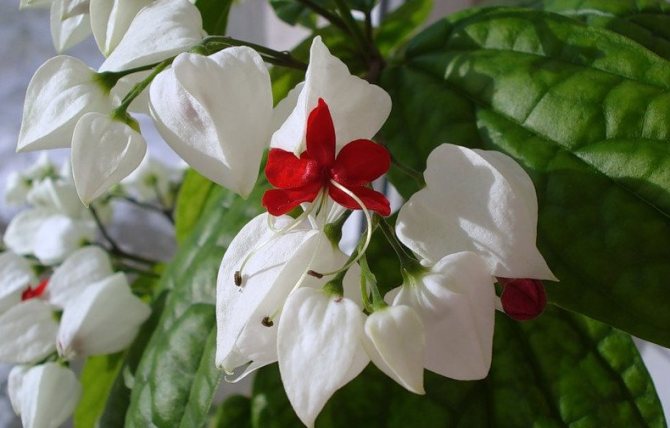

Thompson's Clerodendrum is a popular plant with an unusually beautiful and long flowering. It is quite demanding in care, but the beauty that it gives in return exceeds all expectations.
How to propagate and transplant a flower at home
Young clerodendrum are transplanted annually, adults - every 2-3 years. The plant is propagated in two ways: by seeds and cuttings.
Transfer
The transplant is carried out after leaving the rest period. The procedure is as follows:
- Cover the bottom of the pot with a drainage layer of expanded clay.
- A thin layer of fresh substrate is poured onto it.
- The plant, together with an earthen clod, is placed on the soil. The voids of the pot are filled with fresh soil.
- The soil is slightly trampled.
- Watering and feeding the plant is carried out.
A mixture of peat (1/3), coarse sand (1/3), leafy earth (1/6) and clay (1/6) is used as a substrate.
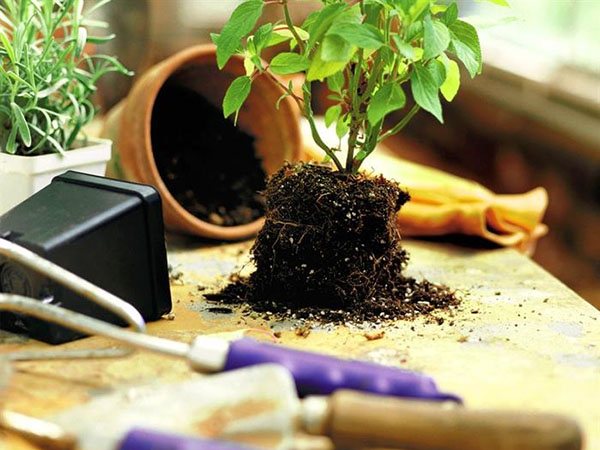

Clerodendrum can be grown in versatile soil by adding a little sand to it.
The flower has very brittle roots, so the transplant is carried out exclusively by transferring from pot to pot. For the same reason, it is unacceptable to stick supports into the pots. They are installed in a pot before the plant is placed there.
Reproduction
Seed propagation is a rather laborious process. To remove a flower from seeds, follow these steps:
- The container is filled with soil consisting of turf, sand, peat.
- Seeds are sown in moist soil. The container is tightly closed with foil, glass or a transparent lid.
- Seedlings are provided with bright diffused light and high humidity. The seed container must be opened daily for ventilation.
- With the appearance of 4 full-fledged leaves, the sprouts dive into separate pots.
The sowing time is determined by the plant from which the seeds were collected. It coincides with a new round of vegetation of the mother plant.
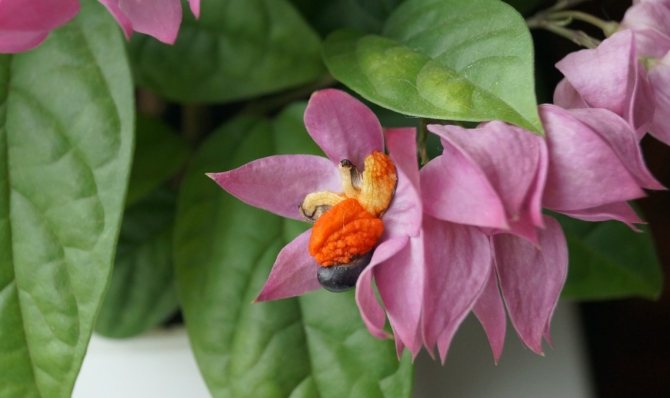

Typically, this is the period from late February to early March.
An easier way to propagate a flower is by cuttings. Shoots cut during spring pruning are rooted in water. The cuttings that have taken root are transplanted into a substrate suitable for the clerodendrum.
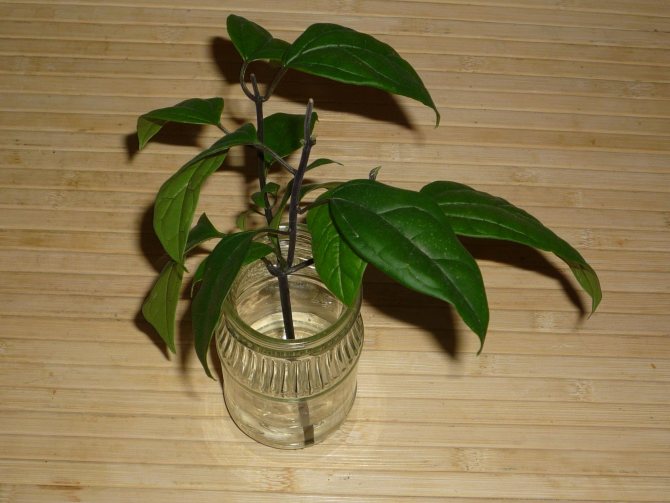

To stimulate the lateral stems, pinch the tips of the shoot.
Difficulties, problems, diseases, pests
This plant needs careful supervision, as it reacts very painfully to mistakes in care. When growing clerodendrum such problems can arise.
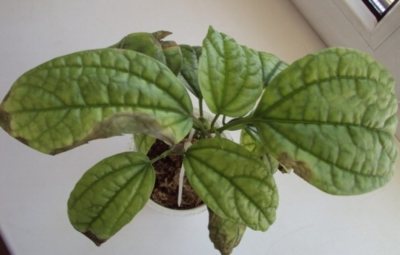

- Falling leaves... This can be caused by poor soil moisture, poor soil, or insufficient air moisture. So that the leaves do not fall off, you need to think about caring for the plant.
- Appearance of yellow or brown markings... The appearance of such spots indicates a sunburn. It is required to remove the plant in partial shade.
- The appearance of insects... This will be evidenced by the cobweb on the leaves and their wilting. To remove insects, you need to rinse the stem under the shower. The damaged elements of the flower must be removed, and the plant itself must be treated with special insect repellents.
Clerodendrum is easy to grow; with its bright appearance, it will decorate any room, creating an atmosphere of coziness and comfort. It is only necessary to follow the rules of care and provide the flower with proper care.
If you find an error, please select a piece of text and press Ctrl + Enter.
Clerodendrum: transplant
The optimal time for transplanting Clerodendrum is early spring, when the flower "wakes up" after a dormant period. Plants under the age of 5 years are transplanted annually, each time increasing the diameter of the pot by 2-3 cm. For adult clerodendrum, one transplant is enough every 3-5 years.
Simultaneously with the transplant, it is advisable to cut off each shoot by a third to make the flower more decorative and "bushy".
If you purchased Clerodendrum from a store, give it 10-15 days to get used to the new environment, then transplant. The universal soil used by indoor plant growers does not take into account the specific needs of the flower.
Destiny flower clerodendrum omens
Clerodendrum is called a life-changing flower that helps households cope with stress and conflict. It often happens that the spouses did not seem to quarrel among themselves, but they got so used to each other that they are annoyed by every movement of the other. This happens as a result of unspoken grievances that are hidden in the heart and float out in heavy silence. Thus, the walls of the house are filled with negative energy. Thomson's flower helps to correct this problem and bring a peaceful mood to the hearts of households, the cyclamen flower will also help neutralize quarrels in the house.
Photo
Here you can see how the flower looks in the photo:
How to make it bloom?
First of all, lush and abundant flowering depends on the observance of the conditions necessary for the plant to develop. The flower grower must properly water the plant, maintain the required humidity, and correctly select the soil and pot for planting.
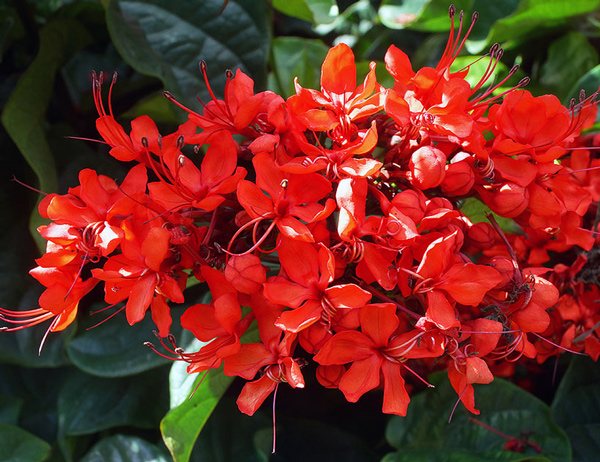

The location of the plant and the temperature in the room where it is kept is important. We must not forget about pruning, which stimulates the development of new shoots. The dormant period in winter plays a huge role in flowering.
The plant must be provided with a cool wintering and careful moisture. The dormant period helps the clerodendrum to recover and gain strength for the next flowering period.
IMPORTANT! Warm wintering and lack of timely transplantation can affect flowering.
Lack of lighting and too high a temperature negatively affect the budding process.
Mr. Summer resident recommends: Clerodendrum - a tree of happiness
Clerodendrum has a positive effect on a person's mood, improves general condition, provides a favorable atmosphere in the walls of the house and gives love.
There is a legend that during the time of Ancient Rome there was a special cult of this plant, it was dedicated to the goddess of love Venus. Each member of this cult met his true soul mate.
But there is also a belief that clerodendrum brings grief, reducing success at work and in the personal sphere. Feng Shui experts strongly oppose this opinion, claiming that any flower brings joy to the house. The price of 150-200 rubles is not a reason to refuse it.
The magical properties of the plant
Despite its exotic origin, Clerodendrum Thompson has been cultivated for a long time in different parts of the world as a greenhouse and indoor plant. In ancient Rome, an unusual liana was called the tree of fate. She was considered a symbol of love and was dedicated to the goddess Venus herself.
People believed that growing the Thompson plant brought happiness and good luck. Of particular value is the flowering of the liana, which reaches a length of several meters. The flowering of the Thompson variety occurs in several stages:
- snow-white sepals;
- scarlet petals;
- stamens;
- light lilac color.
What sort?
The plant has the following qualities:
- growing rapidly;
- the stems quickly turn stiff;
- in winter the flower sheds its leaves;
- vines and various branches are growing rapidly;
- the flowers are heart-shaped with bright red corollas.
Notable plant varieties are After blooming and Albo marginata. The first is famous for the light purple color of the stipule, the second for the superiority of the light yellow tone over the green.
Each of the representatives of Clerodendrum is unique and beautiful in its own way. We suggest that you familiarize yourself with information about such flower varieties as Ugandan, Filipino, the most beautiful, brilliant, specialosum, inerme, prospero, Wallich and Bunge.
Where is the best place to put the plant
The plant loves diffused light. It is located on the west or east windows. If the pot is on the south window, you should take care of darkening. Blooming is unlikely when placed on the north side.
In the summer months, the optimum temperature is up to 25 ° C. It is recommended not to allow the soil to dry out. Provide sufficient moisture in the hot season.
The winter period is considered a dormant time. Clerodendrum Thomson can shed all the leaves. Volkameria requires temperatures up to 16 ° C. Otherwise, flowering will be poor.
Growing clerodendrum from seeds
For reproduction, you can use both purchased seeds and collected from a home plant. The process is quite long, troublesome and does not always allow preserving specific features. The seeds are sown at the end of winter in a micro greenhouse. The mixture is prepared from peat and sand.
The seeds are pressed against the soil, practically without deepening. The germination container is installed in a warm, well-lit place. They constantly monitor soil moisture and conduct ventilation. Seeds germinate for a long time, at least 6-8 weeks. If necessary, the seedlings are thinned out after germination.
Watering and humidity
During the growing season, in spring and summer, watering should be abundant, but with the obligatory drying of the upper layer of the substrate between waterings.
This fastidious lady reacts equally badly to both waterlogging and lack of moisture.
During hibernation the root system and tissues of clerodendron absorb a lot of moisture, so the soil in the pot remains moist for a long time. Water the plant very carefully, no more than once every 7-10 days.
Water should be separated, with a temperature of 22-24 ° C. Be sure to carry out regular spraying, especially when the air humidity in the room is low - in summer or winter when the heating is on.
If the clerodendron for the winter is completely dropped the leaves, then it does not need spraying: just put it away from the battery, and that will be enough.

